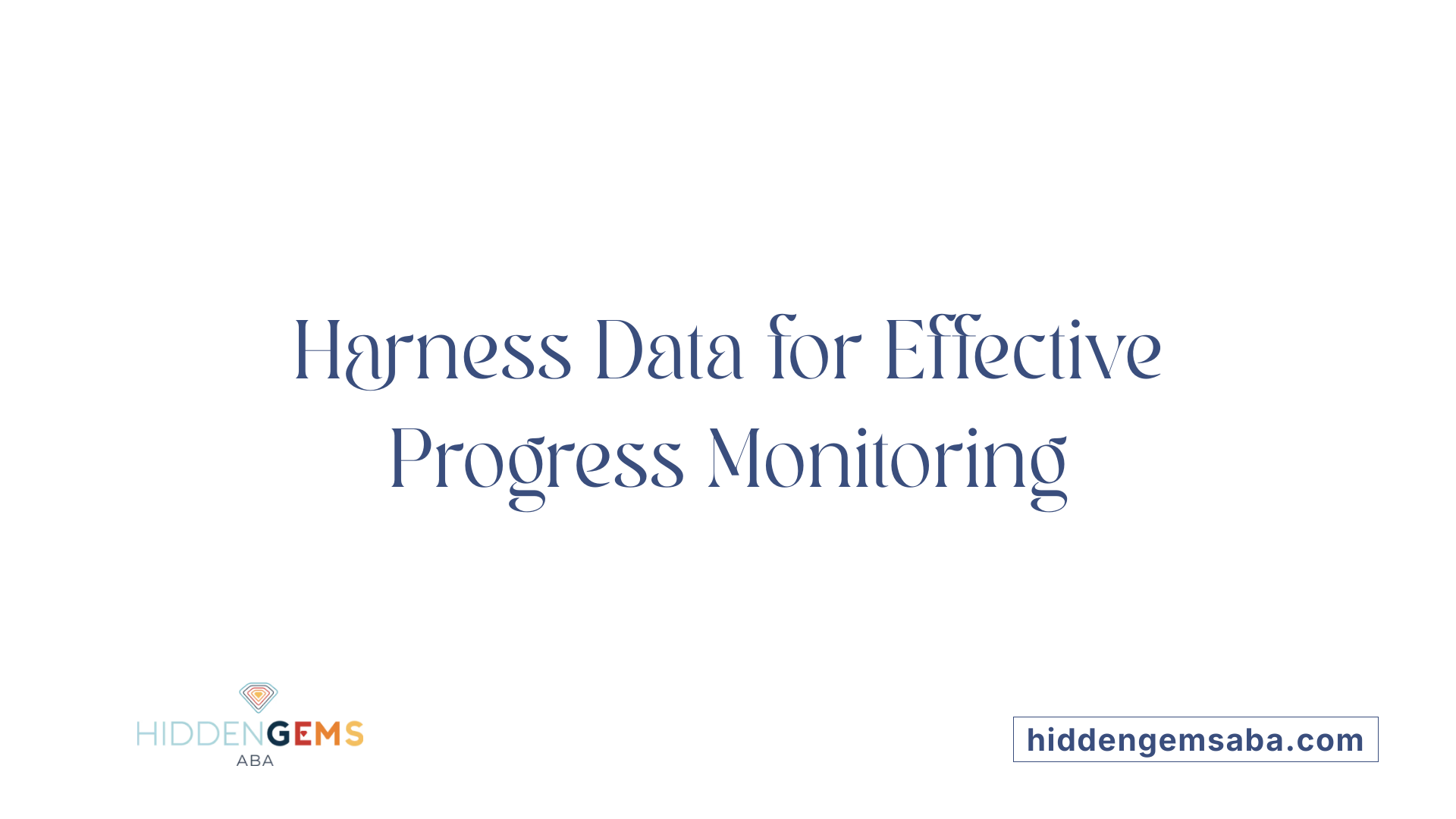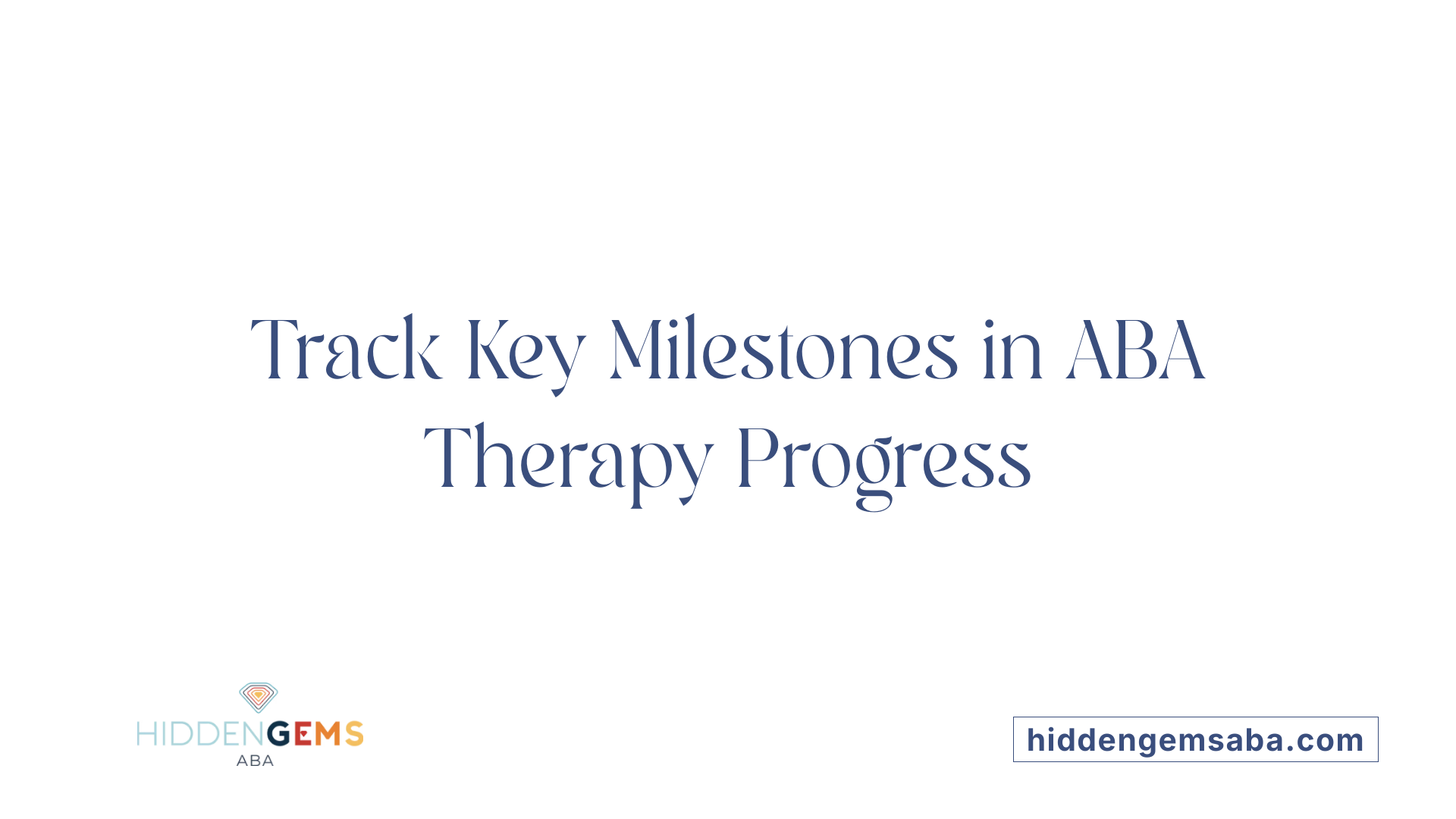Understanding How to Measure Success in ABA Therapy
Applied Behavior Analysis (ABA) therapy is a scientifically supported approach used to improve the lives of children with autism spectrum disorder (ASD). To determine whether ABA therapy is effectively meeting your child's needs, it is essential to understand the criteria, tools, and benchmarks for success. This article guides parents and practitioners through best practices for evaluating therapy outcomes, interpreting data, and ensuring individualized, evidence-based treatment to promote meaningful progress.
Systematic Progress Monitoring and Data Collection

How can practitioners assess the effectiveness of ABA therapy?
Evaluating the success of ABA therapy involves detailed and ongoing assessment methods. Practitioners rely heavily on continuous data collection during therapy sessions to measure a child’s progress over time. This systematic approach enables precise tracking of skills acquired, such as improved communication, social skills, and daily living abilities.
Behavioral assessments are essential in setting and reviewing measurable goals tailored to each child's needs. These assessments focus on understanding the child's current functioning and identifying target behaviors for improvement. Data collected includes information on skill acquisition, behavior reduction, generalization, and maintenance of learned skills.
Long-term evaluation is equally important. It involves monitoring whether new skills are retained after therapy has progressed and if challenging behaviors have been sustainably reduced. Adjustments to the treatment plan are guided by this comprehensive data analysis.
Parent and caregiver feedback gathered outside therapy sessions provide additional insights. Observations from those who interact with the child regularly help assess how skills are generalized into everyday environments. Such collaborative input ensures that progress reports are accurate and reflect real-world improvements.
By combining these data collection practices with behavioral assessments and family feedback, practitioners can determine if interventions are effective and appropriately tailored. This evidence-based approach supports continuous improvements in the child's development, ensuring that therapy goals are met efficiently and meaningfully.
Recognizing Signs of Success and Potential Red Flags

What are the signs of success and red flags in ABA therapy implementation?
Signs of success in ABA therapy include noticeable improvements in a child's communication abilities, such as increasing responses to questions, and enhanced social skills, including better interaction with peers and adults.
Children often show progress in adaptive behaviors like self-care routines—putting on clothes, brushing teeth, or bathing—indicating increased independence.
A key indicator of effective therapy is a reduction in challenging behaviors such as tantrums, aggression, or self-injury. When these behaviors decrease consistently over time, it typically signals positive development.
Generalization of learned skills across various environments, like home, school, or community settings, demonstrates that the child is effectively applying new skills beyond therapy sessions.
Parents and caregivers’ ongoing feedback is essential. Regular reports of observed improvements or continued struggles help evaluate therapy effectiveness and guide adjustments.
Data collection and analysis stand as vital tools; positive trends over prolonged periods often reflect successful intervention. As the child's skills improve, measurable increases in standardized assessments such as the Vineland Adaptive Behavior Scales further confirm progress.
However, certain red flags may suggest the need for reassessment. A lack of observable progress despite consistent efforts could indicate that therapy needs adjustment.
Persistent or escalating dangerous or disruptive behaviors, especially if they become more severe, may reflect ineffective strategies or other underlying issues.
Difficulties in acquiring foundational skills or an increasing tendency towards withdrawal or disengagement during sessions can also be warning signs.
When therapy is conducted without the oversight of qualified professionals, or if engagement is poor and reinforcement strategies are inconsistently applied, the effectiveness of intervention may be compromised.
In such cases, it is crucial to scrutinize whether the program is appropriately tailored to the child's needs and whether the practitioners involved are properly credentialed, such as Board Certified Behavior Analysts.
Ultimately, systematic monitoring through data and professional oversight is essential. Recognizing these signs early ensures that interventions can be adapted to foster better outcomes for the child.
Interpreting Data and Utilizing Results for Decisions

How do you interpret data and results to determine therapy effectiveness?
Effective interpretation of data is vital to evaluating whether ABA therapy is working for a child. Clinicians and parents begin by collecting objective measures— such as how often certain behaviors occur, how long they last, and the intervals between behaviors. This quantitative data provides a clear picture of whether targeted skills are improving or problematic behaviors are decreasing.
Tracking these measures over time reveals patterns and trends. For example, an increase in communication attempts or a reduction in tantrum frequency suggests positive progress. Conversely, stagnation or worsening indicates the need to reassess and modify the intervention.
Beyond numbers, qualitative information from assessments and milestones adds valuable context. Notes from observations, parent reports, and skill evaluations help capture subtle changes that data alone may miss.
By analyzing this combination of quantitative and qualitative insights, therapists and families can determine the therapy’s effectiveness. This process supports making informed decisions about whether to continue, intensify, or adjust the current strategies, ultimately guiding the child's developmental trajectory toward greater independence and social participation.
Best Practices for Evaluating Benefits in Children with ASD

How do clinicians assess if ABA therapy is helping a child with ASD?
Evaluating the success of ABA therapy involves several strategic steps. First, practitioners set up clear and measurable goals right from the initial assessment. These goals are tailored to the child's unique needs and are designed to guide therapy interventions.
Regular progress monitoring is essential. Data collection is systematic and ongoing, providing quantitative evidence of behavioral improvements. This data includes tracking skills such as communication, social interaction, and adaptive daily living activities. Analyzing these trends over time reveals whether the child is making meaningful progress.
Formal assessments, progress reports, and team collaboration play crucial roles in comprehensive evaluation. Frontline therapists, behavior analysts, educators, and families work together to interpret data, modify goals, and adjust strategies as needed.
Considering session factors, such as intensity and frequency, helps determine whether the therapeutic approach is adequate. Additionally, family involvement is vital; active participation and reinforcement at home can influence outcomes significantly.
It’s equally important to evaluate the maintenance of skills over time and across different settings. This ensures that gains are sustainable and generalized beyond therapy sessions.
By employing this multi-faceted, ongoing assessment approach, clinicians can ensure that ABA therapy effectively supports a child's developmental growth, enabling adjustments that maximize benefits and foster independence.
Factors Impacting Effectiveness and Their Monitoring
Which factors influence the effectiveness of ABA therapy and how can they be monitored?
The success of Applied Behavior Analysis (ABA) therapy depends on several important factors. Among these, the intensity of treatment and how well the therapy is tailored to each child's unique needs are critical. Programs that provide frequent, consistent sessions—often 25 to 40 hours weekly over 1 to 3 years—are generally more effective. Customized treatment plans crafted by qualified professionals ensure that goals are relevant and achievable.
Therapist skill and supervision also play vital roles. Highly trained practitioners, especially Board Certified Behavior Analysts (BCBAs), oversee the programs, develop strategies based on detailed assessments, and supervise therapy sessions conducted by Registered Behavior Technicians (RBTs). Ongoing supervision ensures high-quality intervention and proper data collection.
Family involvement and consistency outside therapy sessions significantly influence progress. Engaged parents and caregivers who participate in training and follow-through enhance skill generalization and behavioral improvements.
Regular assessments and ongoing progress reviews are essential for tracking development. These involve collecting data during sessions on skill acquisition, challenging behaviors, and generalization across different environments. Functional assessments like the Functional Behavior Assessment (FBA) help identify the underlying causes of behaviors, guiding personalized interventions.
Data analysis is at the core of monitoring effectiveness. Collected data on behavior frequency, skill mastery, and behavioral reduction are regularly reviewed to evaluate progress. Adjustments are made based on this analysis, ensuring the therapy evolves with the child's changing needs.
Overall, continuous evaluation through systematic data collection, functional assessments, and collaborative review processes ensures that interventions are effective and aligned with desired outcomes. This approach fosters meaningful skill development, reduces harmful behaviors, and supports independence.
Benchmarks and Milestones in ABA Therapy Progress

What are common benchmarks or milestones to assess improvement in ABA therapy?
In ABA therapy, evaluating progress involves tracking various behavioral and skill-based milestones. One of the most noticeable indicators is improvement in communication, such as children increasingly requesting items or activities (manding) and labeling objects or people (tacting). As children develop, they often begin to initiate social interactions, maintain eye contact, and understand social cues like body language or facial expressions.
Another critical milestone is the reduction of challenging behaviors such as tantrums, aggression, or self-injury. When these behaviors decrease over time, it signifies that the therapy is helping children develop coping strategies and functional communication.
Gains in self-care and daily living skills are also essential indicators. These include successful completion of routines like dressing, brushing teeth, and bathing, which promote independence.
Perhaps most importantly, progress is measured by the ability of children to generalize skills across different environments, such as home, school, and community settings. These improvements should be maintained over time, demonstrating sustainable development.
Data collection plays a vital role in setting benchmarks. Regular monitoring of behavioral data, along with ongoing assessments by therapists and caregivers, informs whether goals are being met or if adjustments are needed. This process ensures that therapy is tailored to each child's evolving needs and capabilities.
Overall, milestones in ABA therapy reflect meaningful functional improvements, enabling children to participate more fully and independently in everyday life. Recognizing these milestones encourages continued effort and collaboration among families and professionals, fostering optimal developmental outcomes.
The Role of Qualified Professionals and Program Quality
When seeking effective ABA therapy, the expertise of qualified professionals and the quality of the program are crucial factors.
Central to high-quality ABA services is the oversight by Board Certified Behavior Analysts (BCBAs). These professionals hold a master’s degree, have completed specialized ABA coursework, passed a rigorous exam, and accumulated at least 1,500 hours of fieldwork. BCBAs are responsible for designing personalized treatment plans, supervising therapy sessions, and ensuring that interventions are scientifically based.
In addition, accreditation by reputable organizations like the Behavioral Health Center of Excellence (BHCOE) signifies adherence to high standards of practice. Such accreditation involves evaluations of clinical practices, staff qualifications, and parent satisfaction, providing assurance of program quality.
A comprehensive assessment forms the foundation for individualized planning. This detailed evaluation identifies each child's specific strengths, challenges, and behavioral goals, enabling the development of tailored treatment strategies. This personalized approach increases the likelihood of meaningful progress.
Family involvement plays a vital role in successful ABA therapy. Programs that include parent training and regular communication enable families to reinforce skills outside of sessions, creating consistency and promoting generalization of learned behaviors.
Monitoring progress through consistent data collection is essential. Regular analysis of behavioral and skill acquisition data allows therapists and BCBAs to assess ongoing effectiveness and make informed adjustments to the treatment plan. Supervision by experienced practitioners ensures that interventions remain evidence-based and responsive to the child's evolving needs.
In summary, high-quality ABA programs are characterized by skilled oversight, individualized planning, active family participation, and rigorous data-driven evaluation. Together, these elements foster a therapeutic environment focused on meaningful skill development and long-term success.
Summing Up Key Strategies for Effective ABA Evaluation
Assessing the success of ABA therapy for your child requires a comprehensive approach that combines systematic data collection, behavioral assessments, and collaborative feedback. Recognizing signs of progress and red flags helps ensure timely interventions and adjustments. Establishing clear, measurable goals and understanding the benchmarks and milestones of development are crucial for tracking meaningful progress. In addition, ensuring that therapy is delivered by qualified professionals within high-quality, individualized programs maximizes the likelihood of positive outcomes. Regular review, data analysis, and active family involvement are central to optimizing therapy effectiveness, fostering your child's growth and independence in a supportive environment.
References
- How to Determine if ABA Therapy is Effective
- How to Know If You're Getting Good ABA - Child Mind Institute
- Applied Behavior Analysis (ABA) | Autism Speaks
- What to Look for When Choosing an ABA Therapy Program
- Patient Outcomes After Applied Behavior Analysis for Autism ...
- 5 Signs Your Child Needs ABA Therapy Support
- What Parents Need to Know About ABA Therapy for Autism
- Data Collection in ABA Therapy for Children with Autism
- How Do I Assess the Effectiveness of ABA Therapy?





